Mental health app is a digital solution helping to track and improve your mood, thoughts, social interactions, and self-care. Doctors also use the apps to schedule, monitor, and bill patients. So, mental health apps vary in purpose, design, and features.
The widespread mental issues, such as anxiety, depression, stress, and addiction, cover millions. Yet, medical services are costly, and people that cannot afford them are left alone with their conditions.
Knowing how to create a health app, we decided to share the essential aspects of building one. This guide gives a comprehensive view of the specifics of these robust solutions. So you can choose how to approach mental health app development.
Let’s dive into it.
Market overview
The mental health app market size in 2022 was estimated at $5.2 billion. It is expected to grow at a compound annual growth rate (CAGR) of 15.9% from 2023 to 2030.
The demand for such apps is attributed to common problems that society faces today. Around 50 million people aged 18 and older experience a mental disorder in America, which is 20.78% of the population. A substantial percentage of people who need care (42%) cannot afford it. So, the need for safe and accessible mental health treatment rises.
Although there is a cool down in mental health app downloads after the COVID-19 pandemic spike, the apps keep their positions. As the image below shows, they have roughly 70 million monthly active users and 90 million downloads monthly. So, it shows a good picture of mental health app development.

Source: apptopia.com
The following processes fuel the mental health app market:
- Smartphone adoption;
- Shifting to patient-centric and personalized care;
- High cost of in-person treatment.
Mental health apps provide wellness benefits for a moderate cost. Such apps help you to monitor and improve your mood, meditate, and relieve stress and anxiety. That is why users see personalized care via an app as a cost-efficient alternative to in-office treatment.
As for treating specific mental health issues, such as post-traumatic stress disorder (PTSD), schizophrenia, and bipolar disorder, the apps offer helpful integrations. With these additions, apps help doctors schedule and watch their patients accurately and quickly.
Considering the above factors, mental health app development is a viable idea.
Types of mental health solutions
Before discovering how to develop a mental health app, let’s see what types of such apps are on the market. Different mental health apps address various issues. Some of them developed for maintaining better mental health. Others aim to control specific conditions. Check the table below to see the mental health niches in more detail.
| State or condition | Service | Examples |
| General mental health state |
|
|
| Suicide prevention |
|
|
| Addiction (alcohol, drugs, unhealthy eating, gambling) |
|
|
| Anxiety, panic attacks |
|
|
| Depression |
|
|
| Bipolar disorder |
|
|
| Obsessive-compulsive disorder |
|
|
| PTSD (post-traumatic stress disorder) |
|
|
| Schizophrenia |
|
|
| Mindfulness and meditation |
|
|
Top mental health apps
There are somewhat between 10,000 to 20,000 mental health apps on the market. So, we have chosen the top apps to give you an outlook of their main features and design. Let’s see what they are.
Best overall: MoodKit
It is an app for improving your mood and tracking thoughts, helping to gain control over your mind and life. Two clinical psychologists designed this app and grounded it on cognitive behavioral therapy (CBT).
The solution offers over 200 activities and personalized recommendations on choosing those. The app enables you to add your activities, too. Also, it suggests guidance on changing distressing thoughts with supportive ones. The app includes useful tools, like custom journal templates, mood ratings, mood charts, and custom reminders.
Price: $4.99.

Best for meditation: HeadSpace
The app is designed to help you live with awareness. The resource offers a wide selection of meditations for beginners and experienced users. You can also join meditations with friends or group meditations with members worldwide.
The main app features include meditations for quick mind reset, as well as stress and anxiety relief. Also, the app provides music for boosting productivity and fitness courses for stress release. Additionally, the app features soothing sounds for bringing peace to the mind and better sleep.
Price: monthly $12.99, annually $5.83 per month, and the family annual subscription is $ 99.99.
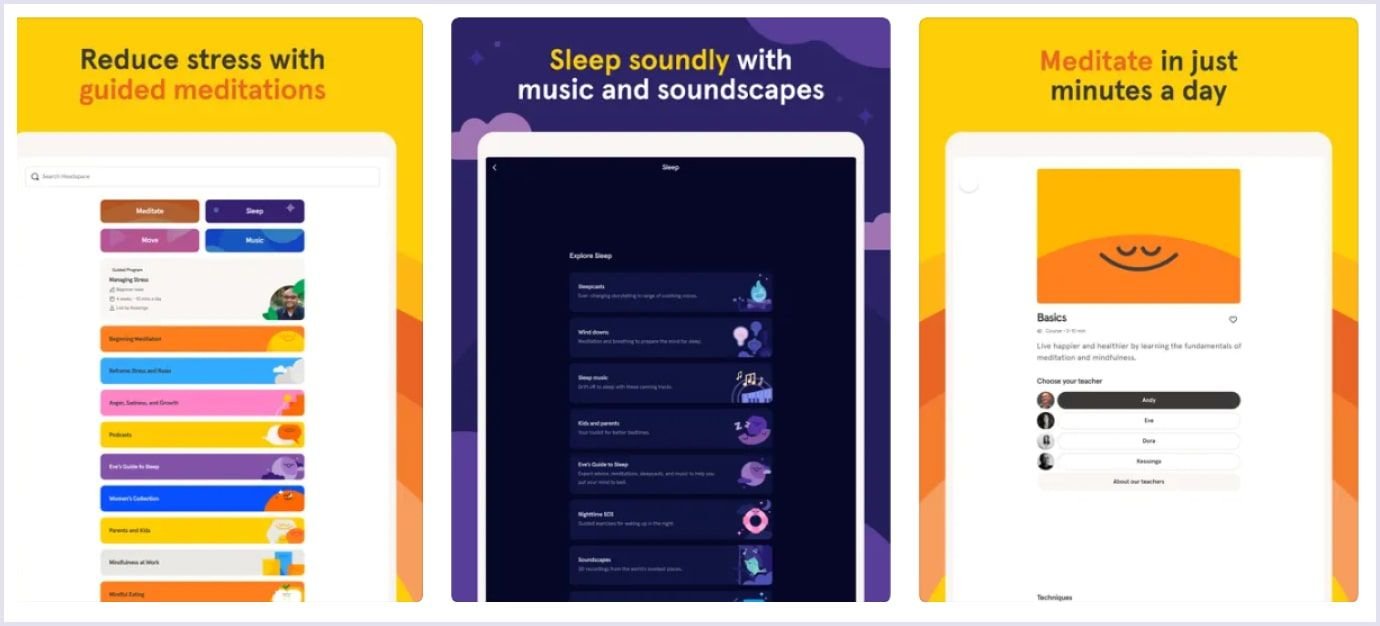
Best for sleep: Calm
This app offers many relaxation techniques and exercises to balance your mood. Thanks to a comprehensive approach, you get a balanced mind, have a night of quality sleep, and wake up refreshed. The main features the app provides include the following:
- Meditations with experts and mindfulness practices for soothing thoughts;
- Calming music, soundscapes, and sleep stories for children and adults;
- Breathing exercises, original programs, and daily moves reducing anxiety;
- Mental health tracker;
- Mindfulness programs for beginners and advanced users.
Price: $69.99 annually with canceling anytime, $399.99 for lifetime access.
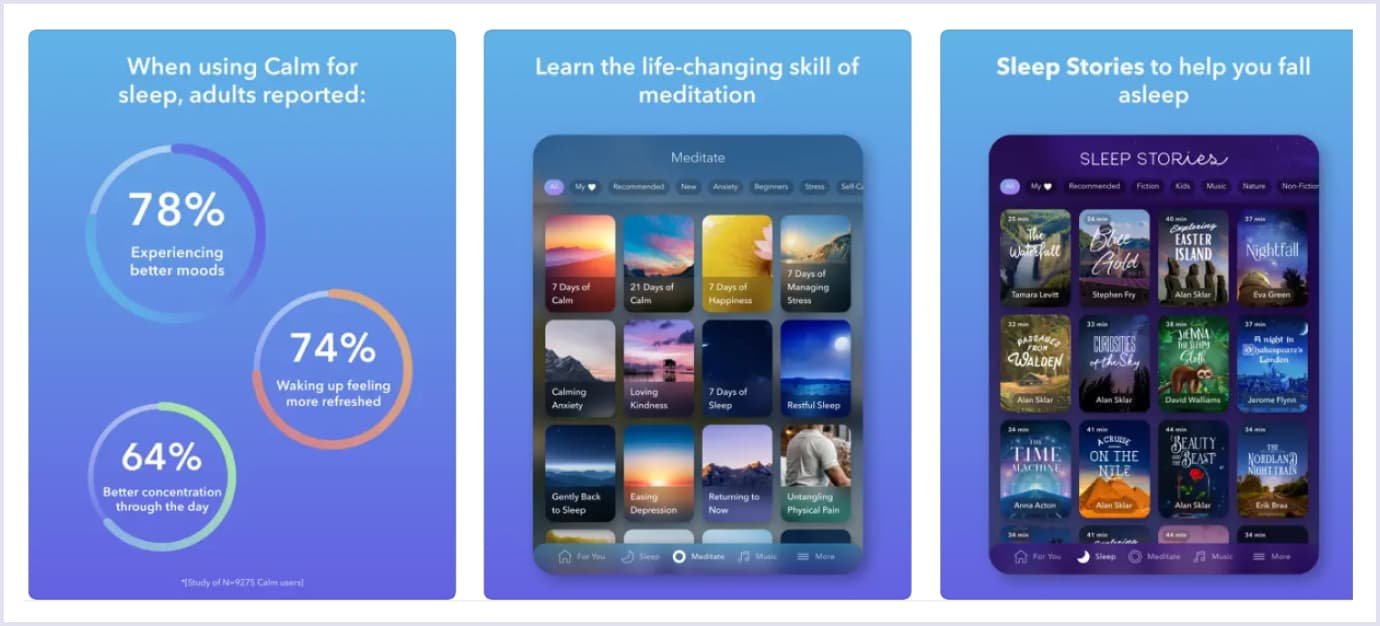
Best for therapy: Talkspace
This app directly connects you with a therapist. The subscription is costly but cheaper than seeing a therapist in person. In addition, you receive 24/7 support in the Talkspace chat room via messaging. Also, you can schedule a live video session with the therapist.
The app allows you to send messages without limitation, such as text, audio, video, and pictures. A user will get an answer at least once a day, 5 days a week. The Talkspace therapists are licensed and accredited by the National Committee for Quality Assurance. They treat the most common mental health issues, such as stress, anxiety, depression, substance use, and more.
The Talkspace app complies with the Health Insurance Portability and Accountability Act (HIPAA). The solution claims safe encryption. Such high standards ensure that your medical data are secured.
Price: subscription plans start from $69 per week.

Best for anxiety: MindShift CBT
It is designed for teens and young adults. Rather than avoiding anxious feelings, you learn to change your thinking. It is a helper that teaches you how to boost your life, withstand intense emotions, and turn to challenging situations.
The app is based on cognitive behavioral therapy (CBT). It includes exercises to relieve anxiety and stress. So you can practice writing thought journals, checking your beliefs, building fear ladders, and challenging your comfort zone. Also, you can participate in online group discussions and give peer advice on coping with anxiety.
Check the video below on how this app works.
Price: free.
Best for boosting your mood: Happify
The app improves your mindset and sets it to positive. The experts involved in developing this solution have experience in evidence-based interventions and CBT. The app allows you to see the positive sides of life with guiding quizzes, games, and activities.
The solution also offers relaxation and mindfulness techniques that relieve anxiety and boost your mood. You can personalize the app according to your objectives. For subscription, you also get access to digital coach services.
Price: free version, $14.99 per month, $139.99 per year.
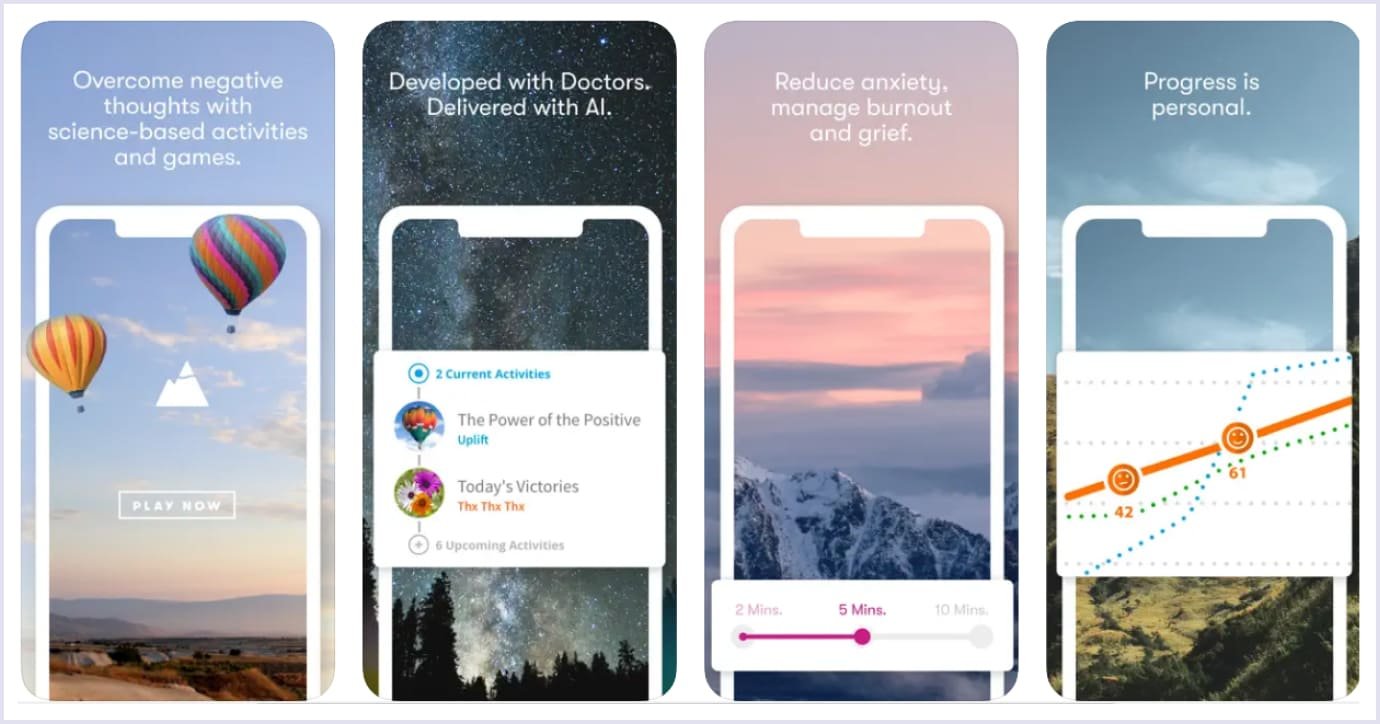
Mental health app development benefits
Developing an app in the mental health niche is a viable project. Let’s discover what are the benefits of creating such an app.
Efficient smartphone interventions
Mobile devices allow people to get psychological help at a distance. Mental health apps provide broad coverage of user care. If customers cannot contact their doctor, they have an app as a preliminary remedy. The main thing to consider is that your product must be based on clinical data and best mental health practices. So, you ensure that users get high-quality support.
Access to mental healthcare 24/7
Regarding how smartphones penetrated our lives, mental health apps give us immediate access to care. Online sessions with therapists and psychiatrists let users get professional help while staying at home. So, being anywhere, users get medical advice. The important thing, though, is the availability of the Internet.
Saving time and cost
Mental health apps include features for providing medical tests and reports. So, patients can upload their examination data, and doctors can view them immediately. Such functionality speeds up the diagnosing process and helps monitor patients’ progress.
The streamlined process brings more customers
As mental health apps improve the counseling process and getting test data, the solutions also increase patient flow to medical institutions. Thus, such advancements bring more customers and a stable revenue flow.

Monetization strategies for mental health apps
There are free and paid mental health apps. To monetize one, choose among the top options described below.

Pay per download
In this model, you ask users to pay for downloading and using an app. Consider competition when you set a price. Do not overprice your app and provide the top services for your customers.
The pay-per-download price varies among apps. The average price makes $0.60 to $1.20. Also, consider that there is a commission an app store takes. For example, Google’s commission per download makes 30%. So you will receive a net 70% of revenue from an Android app.
Freemium
This monetization approach implies that you offer your app to customers partly for free. If your users want to use advanced features, they must pay. The advantage of this model is that you acquire a substantial customer base. The challenge is providing valuable services and features for premium users.
Though you do not have direct revenue from free users, you can discover their behavior with your ad. If you want users to convert to premium users, carefully select your features. Balancing functionality will help you earn more paying customers.
Subscriptions
This method means collecting a weekly, monthly, or yearly fee in exchange for using the app. It is like a contract. Customers pay for a specific time, and an app provider offers services. When the interval ends, a customer can renew or terminate the subscription.
The model benefits both customers and businesses. As a user, you can subscribe and renew a subscription for an app you know you will need. On the other hand, an app provider secures their monthly recurring revenue (MRR). Also, the subscription model helps you leverage customer relationships to retain users for a long time.
In mental health apps, the subscription-based model allows patients to contact their therapists and psychiatrists, get primary care, and receive online help. With this model, a user can access free consultations and discounts on medicines and tests.
In-app purchases
This method means that the app provider charges for features or content available. Customers have access to such resources as long as they use the app. This approach ensures stable revenue and allows providers to experiment with new features.
The benefit of this approach is that you allow customers to choose which feature they want to apply. Users can customize and upgrade the app per their needs. So your customers stay engaged with your app as they receive the services they need.
Read also: Healthcare App Development: Functionality, Approach, and Tips
Essential features for a mental health app
When you think about how to develop a mental health app, it is vital to understand what features you should include. This core functionality covers two sides, a patient and a doctor. We discuss them in more detail below.
Patient’s features
Mental health app is used for patient treatment or personal purposes. Let’s see what features make your app user-friendly and functional for patients.
Sign up and sign in
The sign-up and sign-in process should be as easy as possible. Preferably, limit it to one or two steps. This is the general rule, as your app is for people who are anxious or depressed. They want to solve their mental problems. That is why making this process simple is vital.
User profile
Make it comprehensive so users can add and edit the needed personal information. Items in the user profile include full name, contacts, age, and gender. In addition, the user profile can contain information on chronic illness, allergies, intolerances, and other medical data. Also, consider adding an option for file attachments so that a user can upload tests and reports.

Self-monitoring
This critical feature helps users track their mental health states and disorders. In the case of personal use, it allows monitoring sleep hours, mood patterns, meals, physical activity, and thoughts. If a customer uses an app for a medical purpose, the feature helps to monitor symptoms and treatment progress. So, a patient can handle these data with their doctor.
Enrich this feature with a calendar and checklist. It will make your app more convenient and user-friendly.
For example, the DBT Coach app visualizes the critical parameters for mental health, like skills, emotions, and activities.

Audio and video calling
This feature applies to telemedicine, where video communication is primary. The crucial thing to consider is delivering a smooth and interruption-free experience.
Document sharing
This feature allows users to share medical examinations, monitoring reports, and other assessments with medical personnel, caregiver, or selected family members. You can enrich this feature by retrieving and emailing data in different formats.
Also, you can narrow down sharing for communities of people going through the same crises. It will provide patients with a safe environment to share their daily progress.
Prescription management
As patients receive ongoing therapy, they need to access pill refills. In this case, an adjustable prescription tool is helpful. It helps patients to monitor medication intake. Also, such a tool allows doctors to make prescriptions and assign them to pharmacists instead of writing them on paper. So patients will be able to receive their medications on the go.
For example, the Health Storylines app allows you to input your medicine dose, times of intake, and frequency to get relevant reminders.

Messaging and chats
The feature helps connect patients with their physicians remotely. So patients can exchange live conversations or audio recordings. In self-monitoring apps, this feature allows people to use chatbots.

Emergency feature
People with sudden panic attacks, anxiety attacks, or other mental disorders should be able to contact their physician as soon as possible. Consider making this feature easy to access and use so users can get their caregivers or doctors in one click.
Notifications and reminders
They prompt users to stick to the treatment or personal plan. Notifications can remind you to take a break, walk, take medication, or visit a physician. However, it is crucial to balance notifications so that users are not overwhelmed with them.
Doctor’s features
Conversely, mental health app development includes creating features for doctors. Let’s cover them in more detail, as exemplified by the SimplePractice app for doctors.
Role system
This setup process should be simple and quick, as patients need to know the details of a doctor’s profile. Include the physician’s experience, expertise, and credentials required for patients to select a qualified specialist.
Appointment scheduling
It allows physicians to set the appointment date. You can use integration with the calendars native to a platform, such as Google Calendar or iCal. It also implies that you enable setting treatment sessions to a specific timeframe and include patient lists in the database.

Dashboard with key metrics
The tool should be easy and functional to help doctors monitor patients’ treatment and progress. The metrics included in a dashboard relate to the doctor’s expertise, load, and other needs. So a physician can see the patient’s history, treatment plan, and progress.

Billing plans and invoicing
This feature will streamline the process of charging and invoicing patients. You can also add payment integrations, like PayPal or Stripe. Make sure that this feature works in compliance with the current security standards.

Best tech stack to build a mental health app
Choosing a tech stack for app development ensures proper management of your solution. So you can optimize your app while implementing the necessary features. Considering the significant amounts of sensitive data mental health apps process, choosing technologies that prove their efficiency is crucial. Below, we recommend tools that give the best results for building a health app.
Front-end
React and NextJS. React is a front-end library used to build web app interfaces. React reusable components allow engineers to create flexible, scalable, and performant web apps quickly. NextJS, based on React, helps mental health app developers to solve tasks with routing, data fetching, and integrations.
React Native. As a cross-platform framework, React Native is used for mobile app development. Developers build appealing and performant app interfaces with this framework by applying a set of user interface components.
Back-end
Ruby and Ruby on Rails. We prefer these technologies for fast and efficient development. Ruby on Rails suggests out-of-the-box libraries. Using them, developers create the app functionality and can easily make improvements or changes per the client’s requirements.
NodeJS. It is a Javascript runtime with an event-driven model. Thanks to this, it is perfect for building data-intensive apps running on distributed devices.
Database
PostgreSQL. This open-source database boasts high stability. Its comprehensive functionality supports various data and can define unique complex data types in an app. So, the data processing is refined and continuous.
Integrations and API
Stripe. An advanced payment system suits supporting various payment methods and currencies. It also provides a customizable flow and 24/7 customer support.
Sentry. It is a tool for monitoring apps’ work. The technology catches exceptions and errors users face while running your app. Sentry gathers those errors and presents them on a convenient dashboard.
GitLab. This DevSecOps platform helps mental health app developers to streamline the building process from planning to creating an app. Thus, the team achieves the best results.
Cloud hosting
AWS. It is a safe and versatile environment for cloud computing. The platform offers services for compute power, databases, DevOps, and many more. AWS’s services are separate, and you can configure them according to your needs. So, enterprises and developers widely use this platform.
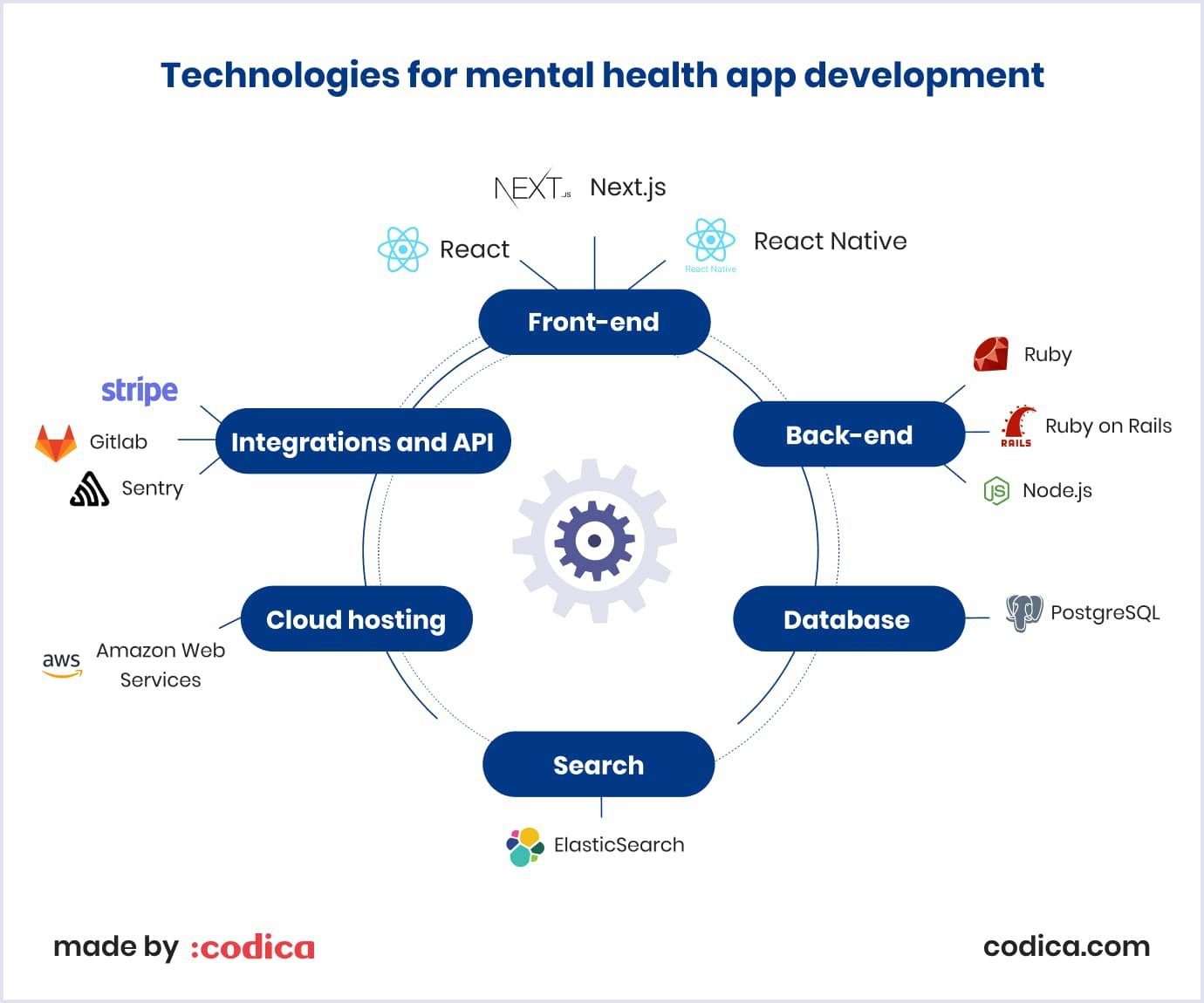
Cost of mental health app development
Calculating the cost of a mental health app depends on its complexity and the development partner’s hourly rates. The following factors influence the professionals’ hourly rates:
- Expertise;
- Experience;
- Location;
- Service type, freelance or agency.
You can choose from the following rates if you want to hire a dedicated team or specialist. Note that the rates vary by location. So, an intermediate developer in North America will charge $119 - $144. Meanwhile, the same specialist will cost you $47 - $65 in Central and Eastern Europe.

If you opt for a freelancer, the hourly rate is lower. For example, a survey states that average freelance mobile app development rates in the US and Australia are around $47. In Canada, the rates are around $28. React Native developers charge $50 - $60, according to ZipRecruiter.
Other platforms report higher numbers. For instance, freelance developers and designers on Toptal charge $80 - $170 hourly.
Below we prepared a table calculated at $50 per hour. The table shows the time to develop a feature or finish discovery, design, testing, or project management.
| The estimated cost of creating a mental health app | ||
| Features | Time, hours | Cost ($50/h) |
| Design | ||
| UX Development | 42 | $2,100 |
| UI Development | 56 | $2,800 |
| Architecture | ||
| Project setup | 16 | $800 |
| DB structure | 32 | $1,600 |
| Integrations | ||
| Payment (Stripe or PayPal) | 32 | $1,600 |
| Electronic health record integration | 64 | $3,200 |
| Main functionality | ||
| Features for patients | ||
| Authorization and security | 72 | $3,600 |
| User profile | 42 | $2,100 |
| Homepage | 84 | $4,200 |
| Self-monitoring | 32 | $1,600 |
| Messaging and chats | 42 | $2,100 |
| Audio and video calling | 48 | $2,400 |
| Document sharing | 64 | $3,200 |
| Emergency contact | 56 | $2,800 |
| Notifications and reminders | 42 | $2,100 |
| Prescription management | 42 | $2,100 |
| Features for doctors | ||
| Profile system | 120 | $6,000 |
| Appointment scheduling | 164 | $8,200 |
| Dashboard with key metrics | 32 | $1,600 |
| Billing plans and invoicing | 136 | $6,800 |
| Non-development activity | ||
| Project management | 48 | $2,400 |
| Quality assurance | 64 | $3,200 |
| Code review | 48 | $2,400 |
| Publication of app | 64 | $3,200 |
| Total | 1378 | $68,900 |
Therefore, the estimated cost of building a mental health app is $68,900. These are rough numbers. Your technical partner will provide you with an exact quote. To choose the right company with reasonable pricing, check their expertise and clients’ reviews first. Thus, you will get the best quality and price for your app.
5 steps when developing a mental health app: Codica’s practice
App development is a comprehensive process involving qualified specialists, time, and resources. Below we share our experience in mental health app development. Read on to discover the necessary steps and practices.
Product discovery
When trying the waters with mental health app ideas, product discovery is significant. It is a stage when we help our clients validate their business idea with market analysis. This phase helps understand users’ needs and solution requirements. Below you can see the key beneficial reasons for product discovery when you plan how to develop a mental health app.
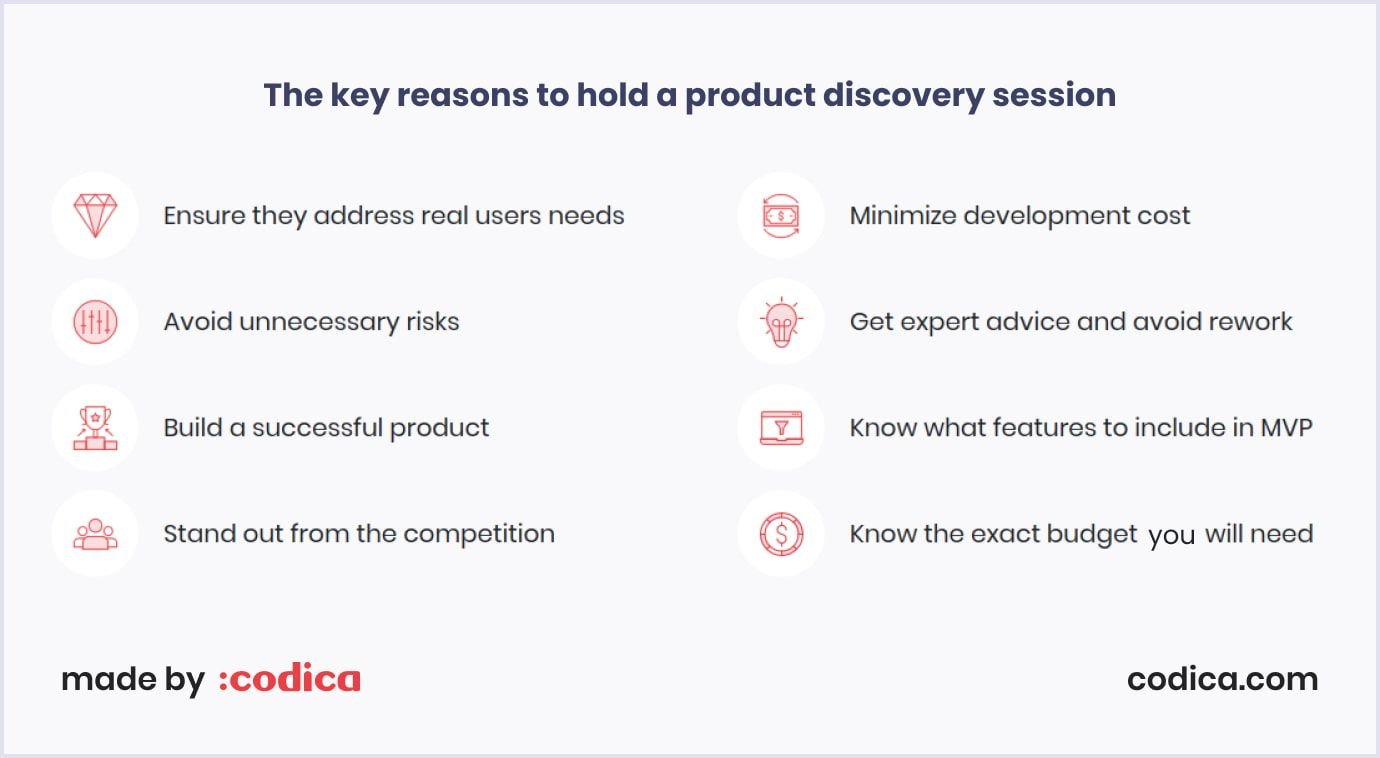
At this stage, our team and a client discuss business and technical requirements for the development setup. The designer and tech lead do discovery research for design and review what features the app must include. The project manager connects the parties involved and tunes up the communication process.
The team provides the client with the project's design, technical, and financial information. As a result of product discovery, you get a set of documents, including the following:
- Clickable prototypes;
- The list of primary features;
- Tech stack and product architecture;
- Time and cost estimates;
- Product specification;
- Advice on the team composition.
Check the video below to learn about the above deliverables in more detail.
UI/UX design
This aspect is essential in every solution as the flow and visuals give the first impression. If users enjoy the app, they will stay with it. Otherwise, they will abandon the app and search for a better option.
The mental health app design embraces usability principles on a high level. There are several considerations that designers should take into account when creating such an app. They are as follows:
- People using such apps are in different states of mind. So, convenience, accessibility, and visual balance are of utmost importance. For example, the Better Stop Suicide app has the feature of recording a message to yourself about why it is worth living. The feature is highlighted in the form of a red button.
- The app should be designed for the real needs of patients, and that is not always what patients say they want. When researching the app features and flow, a designer must take the doctor’s view and clinical evidence as well. This evidence-based approach reveals what patients really need.
- The market moves fast while healthcare waits for clinical trial results and health organizations’ approvals. So, creating mental health app design must be hassle-free. It is a human that an app is created for, so the design must move at its pace and pass thorough testing.
Based on these principles, there are the following design guidelines that ensure better value for the mental health app:
- The app must connect a user with a therapist, family, friend, or emergency line, like BetterHelp;
- Make your design based on clinical evidence, like Pear 004;
- Show empathy in communication, like 7 cups;
- Make the app long-lasting by referring to personal motivations, like Quit Genius;
- Ensure thorough testing of the app design.
For example, the Up! app makes it playful and sympathetic to ask for a user’s location.

At Codica, we use the best practices in our UI/UX design services. Considering the rich functionality of a mental health app, we create an intuitive user experience (UX) and smooth user interface (UI). Optimizing these parts of the app design, we help users easily navigate the app and reach their goals.

Development
When building a health app, we advise using an agile methodology. It will help you move in iterations with interim tests. At Codica, we rely on this principle and discuss the development results in daily and weekly meetings. So we can make changes to custom software development services as soon as possible.
Vital things to consider in mental health app development are as follows:
- Security. Mental health apps process personal data and sensitive information. So, such apps must use efficient encryption, multi-factor authentication, and data backups;
- Interoperability. The mental health field relies on information from laboratories, pharmacies, clinics, doctors, and caregivers. So, the app must be able to process electronic health records with the relevant information;
- Compliance. The mental health app must comply with international regulations on personal data processing, such as HIPAA (Health Insurance Portability and Accountability Act), DPA (Data Protection Act), GDPR (General Data Protection Regulation), and PIPEDA (Personal Information Protection and Electronic Documents Act).
When you develop a mental health app, you can use different tools that help you deliver a compliant and functional solution. Stick to the ready HIPAA-compliant components if you build a telemedicine therapy app or create a chat with recorded messages. Also, rely on DevOps processes as they help you streamline and speed up your development routine.
An illustration of successful app development is a custom fitness app our team created. It is well known that exercise improves overall well-being, including mental health. So, we helped our client keep his customers training during the COVID-19 pandemic. The app connects personal trainers and customers. You can get a trainer's personal workout and nutrition program and track your progress. Check the app look in the video below.
Testing
This stage in the mental health app development embraces various approaches to ensure that the solution is error- and bug-free. It includes the following methods:
- Cross-browser and operating system testing allow for eliminating compatibility issues;
- Graphical user interface testing ensures that the user interface (UI) meets the requirements of font size, colors, simple navigation, and other UI elements;
- Performance testing makes the app functional even with high loads;
- Security testing saves the app from attacks, Internet vulnerabilities, and security breaches.
At Codica, we use manual and automation testing. They help us optimize quality assurance services and identify issues to be removed from an app.
Maintenance and support
When the app is completed and launched, it is vital to keep it working. The solution must be stable and reliable regarding mental health apps connecting patients and doctors or other people for support. Moreover, as users apply it for medical or personal purposes, updates are necessary to deliver the best user experience.
At Codica, we provide constant support for projects. Thus, our clients delight their customers with exceptional experience and security. Our team constantly updates and perfects the solutions to optimize their performance.
Further reading: How to Create a Fitness App: Codica’s Expertise
Codica experience
Healthcare made digital is feasible in many aspects. It streamlines doctors’ work and facilitates many routine processes. Medical apps are helpful for patients who want to send their tests to a doctor or see the doctor in an emergency. The apps can alleviate stress by simplifying the consultation processes for patients and doctors.
With this in mind, our team approached the development of a referral tracking management system. The dental portal aims to improve the work between the dental imaging center and clinics. The video below gives you a grasp of how the solution works.
An advanced dashboard shows the statistics on the number of clinics and referrals. Here, the dental imaging center fills in forms to send dental images. Also, clinics can check the referral status, if it is completed or pending.
A convenient digitized form helps clinics fill out the necessary details on dental imaging. The form is the same as the paper one. Yet checking it is more convenient. Moreover, the referral form contains a messaging system. So, clinics can contact the dental imaging center via chat.
An efficient scheduling system saves time and effort on appointments via the phone. So, the dental imaging center and clinics can process referrals fast and accurately.
The solution has Hebrew writing as the dental imaging center is in Israel. We adapted the app to make it convenient for Israeli clinics.
The client could present the app to early adopters thanks to our minimum viable product development services. After getting customer feedback, we improved the solution to bring it to a new level. The video below shows our client’s impressions of the work with us.
Check our portfolio for more successful projects our team created for various niches.
Wrapping up
Mental health apps are helpful in many ways. They create an environment for developing healthy habits, monitoring your thoughts, tracking your mood, and building social connections. They do not replace in-person treatment but are a great supporting tool for therapy and maintaining wellness.
The need for such apps regarding mental health conditions covering millions of people is urgent. Widespread smartphone usage contributes to market growth. So, it is feasible to turn to mental health app development.
If you decide to create a mental health app, contact us. Our team is eager to help you build a stable and lovable solution.


